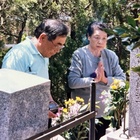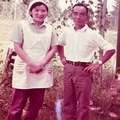Why John and May Never Moved Back to Canada
It remains a mystery why John and May never returned to Canada when it became possible to do so despite their English skills and diverse range of work skills. May stayed in contact with her mother and sisters and would have known that the conditions in Canada were much better than those in postwar Japan. Unlike May, John did not have family in Canada but his close friend James Murakami had established a successful photography studio in Canada and stayed in close contact with him. John’s former employer, Mr. Campbell of Campbell Photography Studio in Vancouver, continued to send him Christmas cards and stayed in contact with him for many years. So, it would seem that there were good reasons for the family to return.
Basil has no recollection of John ever raising the subject during the three years they were together in Wakayama. His sisters also have no recollection of the subject being discussed by him. Megumi wonders if she and Emiko, especially after they were settled in school, were a hindrance to their parents moving back to Canada. Both sisters recall becoming naturalized Japanese citizens and renouncing dual citizenship when they were in grade six of elementary school as a requisite for entering junior high school.
Megumi does think John perhaps had thoughts of returning to Canada as he grew older. And, according to Junko, on at least one occasion he said so. She explains, “When he remarried with my mother, he said Japan was no good and that he wanted to go to Canada. But my mother had never lived outside Kyoto and she said she would not go with him, so he didn’t go.”
In her later life, May did express her wish to return to Canada on several occasions. Megumi vaguely recalls her complaining about life in Japan to her relatives in Canada and saying she wanted to move back there. While visiting Basil’s family in Canada she clearly stated that she wanted to move to Canada and live with his family, although Basil and May’s sisters doubted that she would have wanted to stay once she started to miss her children and grandchildren in Japan.
Attending Redress Explanation Meeting
After the Canadian government’s apology in 1988 for Canada’s unjust treatment of Japanese Canadians during the way and offer of financial redress, May, Megumi, and Emiko attended a redress explanation meeting at the New Otani Hotel in Osaka. They had been previously contacted by Basil who informed them about the redress movement in Canada, and that they could apply for redress compensation although living in Japan.
They took some photo albums with them and showed them to one of the delegation members. At his request, they handed him two photo albums of which he made photocopies and then returned them at the end of the meeting. Megumi recalls feeling very happy when they were informed that they were eligible for the compensation.
Reestablishment of Communication Between the Sisters and Basil
After Basil left his family in Wakayama to return to Canada in 1949, his sisters did not see him again until 1993, when both visited Canada. Basil rented a van and took them around to the various camps in which they had been incarcerated as children. Emiko recalls feeling surprised because the houses in the camps felt smaller than they had imagined from seeing the photos of when they had lived there, and it was hard to imagine that this was really the place where their family had lived.
Basil had always been hesitant to visit Japan, partly due to his indignation that Japan had started the war and had never clearly admitted its responsibility and also because he held some complicated feelings towards his parents. However, his daughter Seiko and a cousin visited Japan in 1992 and were shown around by Megumi and Emiko. Basil felt his attitude begin to change as a result of that visit. In 1994, he and his son finally went to Japan and visited Megumi and Emiko. He says he was glad that he made this visit in spite of his earlier misgivings.

Present Situation of Megumi, Emiko, and Junko

Both Megumi and Emiko married Japanese nationals and live near Osaka. In 1964 Megumi married Shigeo Totani, whose family had a business making futons (Japanese mattresses) in the city of Hirakata. They had two sons. Shigeo passed away in 2018.
In 1971 Emiko married Shingo Wakabe, whose family business was designing baseball caps. They also had two sons and resided in Sakai city. John’s daughter from his second marriage, Junko, is married, has a son and lives in Kyoto.
As far as Megumi and Emiko know, none of their close relatives are presently living in Shimosato although they think the family house is still standing and they do have some relatives living in a nearby town called Nikawa. Their grandmother was their last connection to Shimosato and they occasionally used to visit her there with their children while she was still alive.
Interestingly, they point out that she became a ‘kind grandmother’ and they blame the stress of the war and the dire conditions following the war for her severe treatment of them as children. Megumi says, “That is war—everyone becomes a devil, perhaps.”
Megumi notes that, like her father John and her brother Basil, several of John’s grandchildren became involved in education. One of her sons teaches in the high school of Kyoto Gaidai and is leader of the swimming club there. The other son teaches in a special needs school in Ishikawa prefecture. Previous to that he was working in a special needs school affiliated with Kanazawa University. Her granddaughter Haruka is aiming to become an English teacher and several years ago went to Vancouver and worked at a Japanese school there for several months.
Junko’s son also visited Basil’s family in Vancouver in 1996, and again with Junko and her mother. Megumi and her husband visited Basil again in 1998. Most recently Megumi and Emiko visited Basil in 2024. These days Basil and his sisters mostly communicate by email in Japanese using Romaji (English alphabet).
© 2021 Stan Kirk











